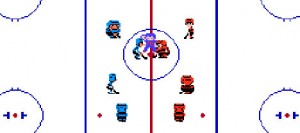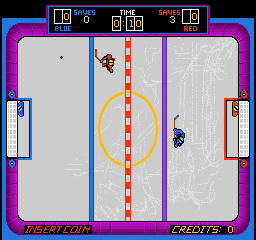With another contentious NHL lockout looming, fans will be searching for something to fill the hockey void. For some of us, the best way to do that is by getting into a game that you can actually have some control over. Rain or shine, the EA Sports franchise will be releasing this year’s installment of NHL in the coming weeks, so what better time to have a look at how the hockey video game has evolved.

The first hockey video game was essentially the first video game – pong. Most Atari sets came with a “hockey” function in which to play Pong. The only difference between regular ol’ pong and hockey pong was that you were given an extra player situated in front of your opponent’s goalie, theoretically making it possible to pass the pixel up to yourself, though as you can imagine this wasn’t very true to life.
It wasn’t until 1981 and the release of the aptly named Ice Hockey for Atari there was a game depicting something close to resembling actual hockey game play. The game was two-on-two, but allowed for some rough stuff, hacking, and tripping. If you were around then, you‘ll remember this commercial for Ice Hockey starring Phil Hartman:
There was somewhat of a halt in the production of hockey video games in the early 80s. Hockey didn’t have the following of other major sports that permitted multiple baseball and basketball games, for example. Still, 1984 brought the early home computer’s Slapshot Hockey and International Hockey which featured some fantastic rock ‘em sock ‘em robot-esque fighting (with a few more head butts).
Then came that weird phenomenon known as The Arcade. A time when video games were exclusive enough that you were to play in public and you had to pay per use. If you remember quarter dispensers, button mashing and tricks to steal free games, you will remember either Blades of Steel (no Will Ferrell to be found) or Hat Trick, two of the only available hockey arcade games. Hat Trick offered the first appearance of ice resurfacing with players who would leave skate marks as the game progressed, and in between periods a strange almost tank-like machine with what appeared to be a periscope at the top would resurface the rink.

Then there was Blades of Steel which offered the most realistic fights around and real NHL teams – although not licensed, they did offer appropriate color co-ordination and city names. Blades of Steel was later adapted for the NES and became a huge success.
Nintendo showed the same creativity as Atari when naming their hockey games with another instalment of “Ice Hockey” for the NES (presumably to differentiate it from the many field hockey video games of that era). As some may remember, this instalment allowed you to select a roster of skinny, average and chunky players. The team selections were based on international hockey with representatives from the US, Czechoslovakia, Canada, Poland, the Soviet Union, and of course, what’s any hockey game without Japan.
Once there was some competition between platforms with the introduction of the Sega Genesis, Super Nintendo and the now-forgotten TurboGrafX-16, there was a hockey game on each of these platforms. The first sponsored game was Wayne Gretzky Hockey for the NES, followed by Mario Lemieux Hockey for the Sega Genesis. Brett Hull would have to wait until ’93 to get his own game.
Then came EA Sports NHL ’91 for the Sega Genesis. This was the first game to get licensing from the NHL, however as things tend to go, the NHLPA didn’t sign off on the deal. While the teams were all well represented no player names were used in actual game play, though Kelly Hrudey was prominently displayed on the cover.
The franchise, skipping the ‘92 installment altogether, released NHL ’93, which was finally able to get licensing from the NHLPA… but not the NHL. This meant players names were used, but team names were not. (Yeah, this piece doubles as a history of inconsequential NHL/NHLPA disputes. You’re welcome.) The NHL and NHLPA came to terms on NHL ’94 and both the team and player names were used. The success of the EA franchise early on can be chalked up to its ability to customize gameplay by adjusting penalties, offsides, and more. The EA games were given a mainstream shoutout in the 1996 Vince Vaughn comedy Swingers:
From this point on games came and went, with more unrealistic arcade-style games like Hit The Ice which involved “street-rules” hockey, much like the later NHL Hitz franchise, and cartoon goon hockey players. And of course there was the Mutant Hockey League game in which you can chose from a team of robots, undead skeletons or trolls. That game involved exploding pucks, referee bribes, landmines, “demon goalies” and an array of other nonsense.

The games into the late ‘90s and 2000s stuck to more realistic gameplay. The one exception was Wayne Gretzky’s 3D Hockey, which allowed goalies to transform into literal brick walls. This game was intended to compete with the increasingly life-like EA games. Into the 2000s the competition between hockey video games came down to the EA Sports camp and the 2K Sports camp, going back and forth with installments each year until the EA Sports franchise won out after 2K announced they would be discontinuing the franchise in 2011.
Now, lockout or not, you can rest assured you have some quality gaming ahead of you in which your favourite team may actually conceivable win the cup, though even in an unrealistic video game world, Leafs fans probably shouldn’t count on it.
An enjoyable read, but you made many factual mistakes. Not trying to start a flame ware here, but…
“Computer Space” was released one year before “Pong”, so “Pong” was the second–and not first–commercially available video game.
In 1979, “NHL Hockey” was released for the Intellevision, and featured 4-on-4 action. The players were stick figures with sticks, which was a big step up from the “pong” paddles seen in games like “Video Olympics.”
That same year, “Hockey! Soccer!” was released for the Odyssey 2. It was 6-on-6, and used little hockey guys. So, while “Ice Hockey” for Atari was good for its time, it was preceded by two games that were more “hockey-like” in appearance and in game play.
“Hit the Ice” was also a coin-op arcade game, so there were at least 3 hockey arcade games.
There was no game called “NHL ’91.” EA’s first hockey game was called “NHL Hockey” and was released in 1991. It had team names, but not player names.
Likewise, there was no game called “NHL ’93”–it was actually called “NHLPA ’93” and was released in 1992. This game had no team names, but had the player names.
Sal
http://www.PuckJunk.com
and this is why PuckJunk.com s your source for obscure facts
flame war*
If you didn’t grow up playing blades of steel for NES you didn’t have a proper childhood!
And Ice Hockey! Saameee
Big thumbs up for the inclusion of the legendarily-bad-but-awesomely-playable Mutant Hockey League.